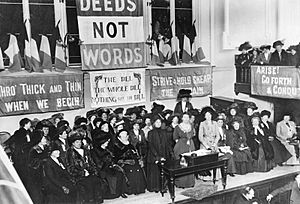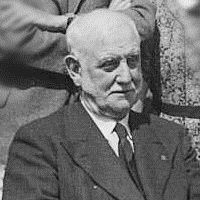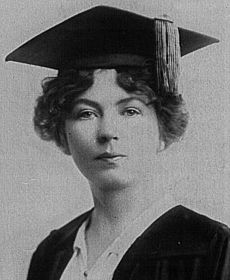Marion Coates Hansen facts for kids
Quick facts for kids
Marion Coates Hansen
|
|
|---|---|
| Personal details | |
| Born | 3 June 1870 Osbaldwick, Yorkshire |
| Died | 2 January 1947 (aged 75) Great Ayton, Yorkshire |
| Political party | Independent Labour Party Women's Social and Political Union Women's Freedom League |
| Spouse | Frederick Hansen |
Marion Coates Hansen (born Coates; 3 June 1870 – 2 January 1947) was an English activist who fought for women's rights. She was a strong supporter of women's suffrage, which means the right for women to vote.
Marion was an early member of the Women's Social and Political Union (WSPU). This group used strong methods to get attention for their cause. Later, she helped start the Women's Freedom League (WFL) in 1907.
She is known for helping George Lansbury, a Labour politician, to support votes for women. She worked as his campaign manager in the 1906 election. Lansbury then became a very important supporter of women's voting rights before 1914.
Marion Coates Hansen lived most of her life in Middlesbrough. She was an active member of the local Independent Labour Party (ILP). She came from a wealthy family. She became interested in socialism after working as a nanny for Joseph Fels, a social reformer, in Philadelphia in the early 1890s.
She left the WSPU because she disagreed with how Emmeline Pankhurst and her family ran the group. After the First World War, Marion became a local councillor in Middlesbrough. She worked on improving housing and clearing slums. Historians have often overlooked her contributions, focusing more on other well-known figures.
Contents
Early Life and Beliefs
Not much is known about Marion Hansen's early life and education. She was born Marion Coates in 1870 in Osbaldwick, Yorkshire. When she was young, her family moved to the Linthorpe area of Middlesbrough.
She had two older brothers, Charles and Walter, who became successful businessmen. They were connected to the American reformer Joseph Fels. Through this connection, Marion traveled to Philadelphia in the late 1880s or early 1890s. There, she worked as a nanny for the Fels family.
While in America, Marion was inspired by the poetry and ideas of Walt Whitman. When she returned to England, she became a strong supporter of socialism and women's rights. She wrote in a socialist newspaper called Justice. She argued against the old ideas that limited women's roles in society.
When one socialist leader said women should be "charmed" by socialism, Marion wrote back strongly. She said, "We women are not going to be bought like goodies... We are coming as comrades, friends, warriors." Around 1900, she married Frederick Hansen. His family was also well-off and shared socialist beliefs.
The Coates and Hansen families were important members of the local Independent Labour Party (ILP). Marion was a key leader as the branch secretary. Her group was sometimes called "the Linthorpe set." Their strong influence sometimes caused disagreements with other members. Marion's growing interest in women's rights also sometimes conflicted with her ILP duties. In 1903, she joined the Women's Social and Political Union (WSPU) when it was first created.
Fighting for Women's Votes
The WSPU and Its Goals
The WSPU was founded in 1903. It broke away from another group, the National Union of Women's Suffrage Societies (NUWSS). The NUWSS, led by Millicent Fawcett, tried to get women the vote slowly and peacefully.
But some NUWSS members, led by Emmeline Pankhurst and her family, wanted faster action. They wanted women to have the same voting rights as men. So, they started the WSPU with the motto "Deeds not Words."
At first, the WSPU did not use disruptive actions. But this changed in 1905. It seemed that peaceful efforts in Parliament were failing. In February 1905, a bill to give women the vote was discussed in the House of Commons. But opponents talked for so long that the bill never got voted on.
The WSPU realized that the Liberal Party would soon be in power. They wanted the Liberals to promise to give women the vote. When the Liberals did not make this promise, the WSPU started using more aggressive methods. They began interrupting Liberal party meetings. Christabel Pankhurst and Annie Kenney were even jailed for disrupting a meeting.
Working with George Lansbury
Marion Hansen first helped the WSPU in September 1905. She helped the socialist activist George Lansbury become a candidate in the Middlesbrough election. He promised to support votes for women.
Lansbury was a local councillor and worked to help the poor in London. Marion knew him through her family's connection with Joseph Fels. Fels had worked with Lansbury on projects to help unemployed people.
The local ILP could not officially support Lansbury because of a deal with the Liberal Party. Marion tried to get around this rule. She wrote to Ramsay MacDonald, a Labour Party leader. She explained why supporting Lansbury would be good for the Labour movement. But MacDonald could not help. So, Lansbury ran as an independent socialist.
Marion convinced Lansbury to include women's voting rights in his campaign. He also supported other socialist ideas like state pensions and workers' rights. Marion was very involved in his campaign and acted as his agent. This angered some in her local party. But she did her job calmly and efficiently. Her husband, Frederick, was the campaign treasurer. Most of the campaign costs were paid by Joseph Fels and Walter Coates (Marion's brother).
However, in the January 1906 election, Lansbury lost badly. The voters, who were mostly working-class men, did not support his socialist ideas. He received less than 9 percent of the total votes.
Marion Hansen was the main person who introduced Lansbury to the idea of women's suffrage. He thanked her for this in a letter in 1912. George Lansbury later said that women's rights became his most important concern. After he became a Member of Parliament in 1910, he told Marion he doubted other Labour MPs would help women get the vote.
In 1912, Lansbury gave up his Parliament seat to fight for women's votes alone. Marion strongly disagreed with this decision. She was very sad when he lost the next election. In August 1913, Lansbury was jailed for supporting the suffragists' strong actions. Marion wrote to him, saying, "You have done a big thing for us."
Marion also cared about Lansbury's family. She became good friends with his wife, Bessie. She invited Bessie to stay in Middlesbrough for a holiday. She felt Bessie needed a break from her large family.
WSPU Activist and New Paths
After the 1906 election, the WSPU was active in other elections. Marion Hansen took part in several of these campaigns. In August 1906, at Cockermouth, there was a disagreement within the WSPU. Some wondered if they should support Robert Smillie, an ILP candidate. Smillie supported women's suffrage generally, but he thought trade union reforms were more important.
Christabel Pankhurst and others decided to campaign against all candidates. This caused problems for members like Marion Hansen and Mary Gawthorpe, who were loyal to the ILP. Although Mary Gawthorpe spoke for Smillie, Marion followed Christabel's plan. This made her local ILP even more upset and she temporarily resigned as secretary.
In her memories, suffragist Hannah Mitchell described Marion Hansen during this time. Mitchell remembered Marion campaigning in Huddersfield in November. Later, when Mitchell was ill, Marion took care of her. Mitchell wrote that Marion's home was "lovely" and that the Hansens were very kind.
The WSPU grew quickly. But many members were unhappy because the group was not democratic. They also felt it was losing touch with the Labour movement. In September 1907, Emmeline Pankhurst changed the WSPU's rules. She appointed her own committee members. Because of this, many members, including Marion Hansen, left the WSPU.
They then formed the Women's Freedom League (WFL). The WFL was also committed to active protest but had a democratic system. Many working-class WSPU members joined the WFL. The WFL also tried to have better relationships with the Labour Party in Parliament. Marion Hansen, along with Charlotte Despard and Teresa Billington-Greig, joined the WFL's first executive committee.
The Women's Freedom League
Even though Marion helped create the WFL, there are not many records of her specific actions for the group. However, her letters to George Lansbury show she remained very dedicated to women's suffrage until 1914.
She might have been one of the WFL members who tried to give a petition to King Edward VII in 1908. She might also have joined the large protests outside the House of Commons and 10 Downing Street in 1909.
Marion's future sister-in-law, Alice Schofield (who married Charles Coates in 1910), was more visible. Alice was an active WFL organizer and was jailed in 1909 for protesting at the House of Commons. Although Marion and Alice shared similar political ideas, they were not close friends. Alice Coates's daughter said in 1975 that the two women disliked each other and kept their distance.
Later Life and Legacy
After the First World War, the women's suffrage campaign mostly stopped. Marion Hansen does not seem to have continued her WFL activities. In 1919, she and Alice Coates became the first women elected to Middlesbrough Borough Council. Alice was elected just a week before Marion. They were among the few active suffragists who went into local politics.
As a councillor, Marion focused on clearing slums and improving housing. In the 1930s, she spoke out against destroying old houses in the St Hilda's area. She believed many of these houses were well-built and beautiful inside.
From 1911, Marion, who did not have children, lived with her husband in the Nunthorpe area of Middlesbrough. After Frederick Hansen died, Marion lived in Great Ayton, outside Middlesbrough. She passed away there on 2 January 1947.
George Lansbury described Marion as a "very slightly built woman." He said her "frail body possesses an iron will and a courageous spirit." He added that she fought for a freedom that would help people's bodies, souls, and spirits.
Historians have often forgotten Marion Hansen. Her name is rarely mentioned in books about the suffragette movement. The local history group in Nunthorpe calls her "an extraordinary feminist whom historians have forgotten."




